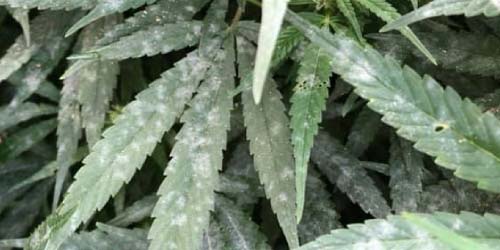
Mildew is one of the commonest diseases that affect weed plants. If there are what look like snowflakes permanently present on your weed plant’s leaves then you know that your plant is suffering from mildew. There are 2 forms of leaf blotch disease which you need to deal with quickly once you’ve noticed either of them. It’s not at all difficult to tackle mildew. You just need to know how! You can read more about this white rot in this article which also provides some handy tips for eliminating it.
In this article:
- What is Mildew?
- Mildew and Weed
- True or False Mildew
- True Mildew | White Rot
- Dealing with True Mildew in Weed Plants
- False Mildew | Leaf Blotch
- Dealing with False Mildew in Weed Plants
- Preventing Mildew and Other Diseases in Weed Plants
What is Mildew?
In actual fact, mildew is merely a fungal infection, the spores of which have ended up on your plant carried by the wind or insects. However, once it gets onto your plant it can spread like wildfire given favourable conditions. Mildew comes in 2 forms which can make it tricky to recognise the disease sometimes. There is true mildew and false mildew. Two different fungal infections which have to be treated differently. We will explain what that means exactly later on. You should be clear about one thing though – if you see mildew on your weed then you need to act immediately. Or before you know it your beloved weed plant will be completely mouldy and you can throw it away. That’s the last thing we want.
Mildew on Weed?
Under favourable conditions, mildew spreads like wildfire. When you cultivate weed, you often create the ideal conditions for mildew. An unfortunately good combination therefore. That is the reason that mildew often occurs in weed. What are the consequences of the mould for your weed plant? True mildew can cover your plant completely with a thick layer of white fluff. Via the fluff, the mould penetrates the cell wall from where it deprives your weed plant of food and water. False mildew, on the other hand, has a significant effect on the leaves of your weed plant. It continues through to the leaf’s tissue, causing mould blotches on your plant. This is why it’s so important to tackle mildew in weed plants. Just as soon as you see it!
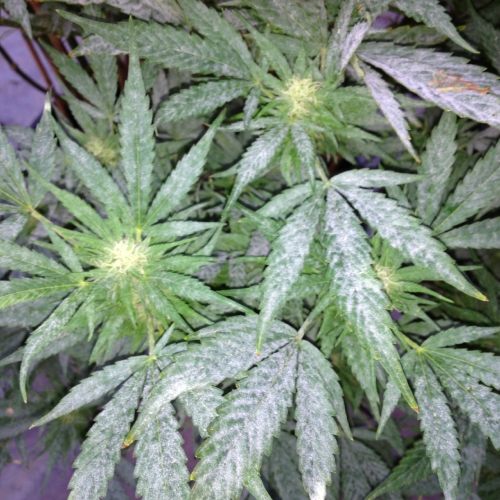
True and False Mildew
Mildew occurs in weed plants much more often than mealybugs or slugs, for example. In particular, that is because there are 2 fungal infections that we refer to as mould: true mildew and false mildew. True mildew is also called white rot and not for no reason. When you have a serious mildew infection in weed, it looks like the photographs above. A white-grey fluff that starts with blotches on the upper surface of the leaves but quickly develops into a veritable snowstorm. Its less recognisable brother, false mildew, is mostly to be found on the underneath of the leaves. The grey fluff is therefore less noticeable and as a result you are often too late to tackle mildew in weed. If you are not dealing with false mildew, then this will quickly become obvious because yellow and brown spots appear at the top of your weed plant.
Now that you know how to differentiate and recognise the 2 types, it’s time to explore more deeply how to deal with mildew. And it can be fixed.
True Mildew | White Rot
True mildew is the most recognisable of the two. It produces a white fluff on your weed plants that you have to stop in its tracks. If you don’t, then not only the weed leaves but also the buds and branches will be affected. Once your weed buds become infected with true mildew you cannot get rid of it and your cultivation is doomed to failure. The white rot creeps deeply into the cell walls of your weed plant. There, as it were, it sucks up all the water and nutrition that your weed plant greatly needs to grow, flower and survive. You will know that true mildew has done its work if you see that the leaves on your plant are covered with white fluff, and are curled and dried up. In order to prevent this, you can tackle true mildew with the tips shown below!
What is everyone’s logical response if they come across true mildew on their weed plants? To try and spray or rub off the white fluff. It’s true that you can manage to do this but it won’t help. It will come back astonishingly quickly! In this way, you can tell though whether your are dealing with true or false mildew. False mildew won’t come off the plant but true mildew does. Even so, this is only temporary.
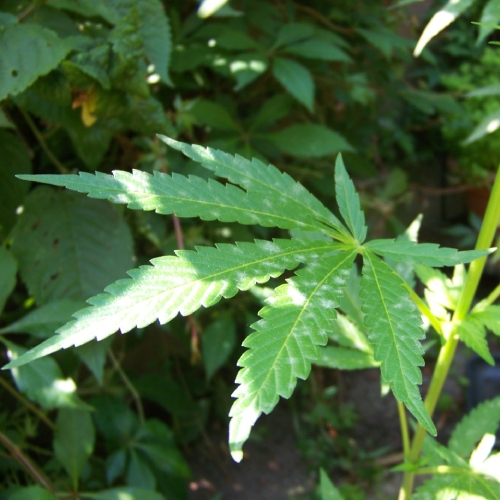
True mildew has infected the weed foliage You can tell this by the white spots.
Dealing with True Mildew in Weed Plants
Have you noticed white fluff and are sure that it’s true mildew? In that case, it’s time to consign it to the bin. To do that, it makes sense to gain in-depth knowledge about the conditions that true mildew appreciates. The white rot loves dry conditions and thus low humidity in your growing area is to the advantage of an infection. For that reason, true mildew occurs more commonly during flowering because that’s when you often arrange for a drier climate. Do you want to get rid of the white rot? If so, start by maintaining the right level of humidity in your growing area. Use the following tips:
Natural fungicide: you can tackle true mildew with a simple mixture of milk and water. Many growers have eliminated the fungal infection by this means. The reason it works is because moulds are averse to protein. Something in which milk is naturally rich. This is what you do: mix 100 ml milk with 900 ml water in a spray bottle. Spray your weed plants thoroughly with the mixture, especially the areas where the most mildew is visible. It’s then important to allow the weed plants to dry off well in the sun. Otherwise this natural pesticide is pointless. Is the milk mixture not working? Add sodium carbonate (soda) and try again!
Highly effective non-organic solution: are you not particularly bothered whether your control method is natural or not? In that case you should go for the most effective method. Look for sulphur solutions and/or fungicides. These act to kill moulds and will deal with the mildew in no time at all. Dust this over your weed plants and leave it to do its work. Important tip: is your weed plant already starting to flower and does it have buds already? Try to avoid dusting the buds! It could affect the taste of your weed and it’s certainly not healthy.
Using these methods you’re sure to succeed in tackling true mildew. The white fluff will disappear and it won’t come back. Check thoroughly that all the mould has disappeared from all your plants. If any is still left then the white rot can make an unexpected comeback.
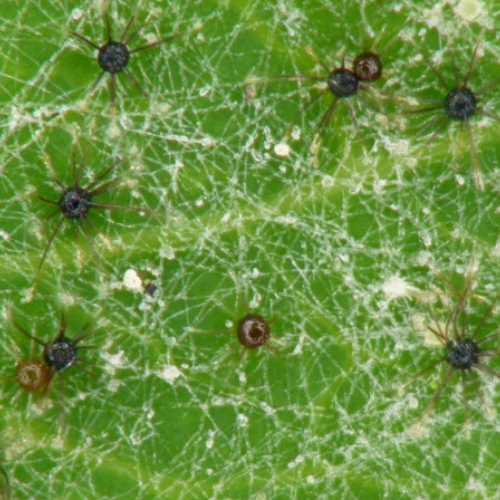
Microscopic images of true mildew. The black spots are fruiting bodies. These are responsible for producing the spores of the mould.
False Mildew | Leaf Blotch
False mildew works a bit differently from the true variant. This leaf blotch disease, or whatever you choose to call the fungal infection, doesn’t start so obviously on top of the weed leaf. Instead of a white fluff, a grey fluff appears on the underneath of the weed leaves. The leaf blotch disease is a bit more stubborn because in no time at all it can penetrate the interior of the leaf where it affects the cell wall and the tissue. If you don’t discover false mildew underneath, you will notice it all too soon on the upper surface of the leaf. Angular, yellow patches are the result. Hence the name, leaf blotch disease. If you still do nothing about it, then the blotches will turn brown and by then the damage is usually done.
False mildew likes wet, not dry, conditions This is why false mildew often appears at the beginning of cultivation because that’s when you need high humidity. In addition, leaf blotch disease is very fond of a hot climate. If you need to deal with a serious mould infection, lower the humidity and the temperature, and check out the following tips.
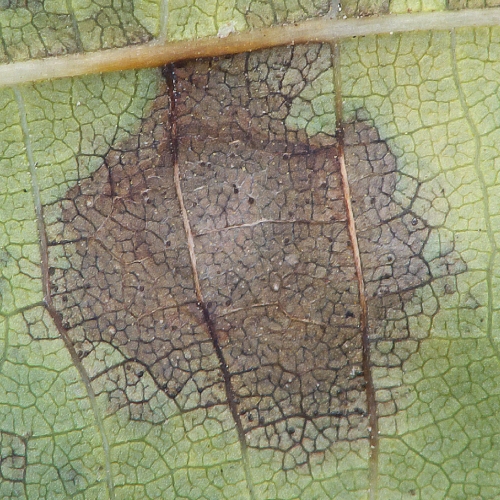
A leaf that has been affected by leaf blotch disease | false mildew
The Correct Humidity for Weed Plants
These 2 fungal diseases largely determine the ideal humidity for your weed plant. The correct relative humidity is preferably quite high during the growing phase. 65 to 70% is really good. Why? The immature plants have not yet developed a good root system and are better able to absorb moisture from the air via the leaves. A mature plant that is not yet in flower can tolerate a lower percentage of moisture. Lower the humidity each week by around 5%, down to a minimum of 40%. Is the plant about to flower? In that case lower the humidity to a value between 40 and a maximum of 50%.
It’s a bit like the ideal temperature in your growing area. Don’t lower the temperature during the growing and early flowering phase to below 21 degrees Celsius. In the final 2 weeks before the harvest, you can lower the overnight temperature by 5-10 degrees compared to the daytime temperature (18-24°C). If you keep the temperature and humidity under control, then neither true or false mildew will get any chance.
Dealing with False Mildew in Weed Plants
False mildew is highly dependent on moisture. Without moisture, it cannot propagate itself. But, of course, your plant also needs it to grow big. Particularly when it’s still a cutting, seedling or tiny plant. You can reduce the humidity slightly but not too much because that would then make the ideal conditions for true mildew! As you can see now, humidity is incredibly important for preventing fungal infections. You can tackle false mildew in two ways:
Natural fungicide: there is a natural counterpart to false mildew in the plant kingdom. Would you like to deal with the mould in an organic way? If so, then engage the help of the field horsetail. Also known sometimes as mare’s tail, horsetail is an effective fungicide against mildew. Gather about 100 grammes of fresh horsetail. Fill a large jug with water and leave the horsetail to soak in it for a day. Then sieve out all of the plant material and spray your weed plants all over with the mixture. It’s best to do this in the morning so that your plant can dry more quickly. In this way, you’ll avoid getting other nasty moulds, diseases or insects.
Very effective non-organic solution: just like the fungicides for true mildew, there is a fast solution for false mildew as well. Not completely natural, so you have to really want to do it! If you want to see the back of the false mildew quickly, buy a solution of lime and copper sulphate. Spray your plants with it, again being careful with the lovely buds. It’s better not to spray them. Allow the plant to dry and in a very short time the mould will be gone.
One annoying property of false mildew is that it’s not that easy to tell if it’s gone. If the mildew has badly affected your leaves, the blotches won’t actually go away. So don’t just carry on spraying until you no longer see blotches but keep a good eye out for new mould coming. Tip: remove only the weed leaves with brown blotches. It’s best to leave small yellow blotches alone. Because removing leaves is not really ideal. Only if the leaves are almost dead and are taking moisture and nutrition away from the rest of your plant should you remove them.
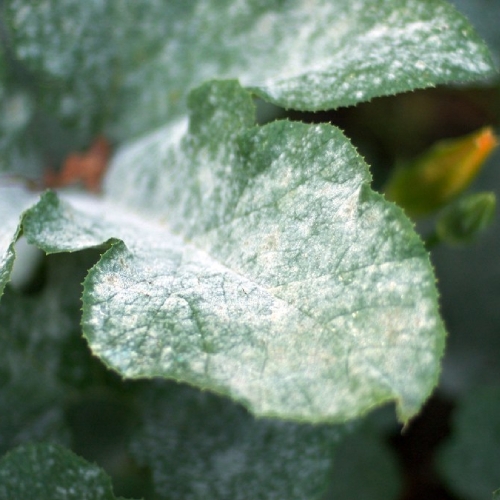
Preventing Mildew and Other Diseases in Weed Plants
You have read the information about false and true mildew and know what conditions the two diseases like. You know, therefore, how to avoid an infection. But humidity and temperature are not the only elements that cause diseases in weed plants. Other aspects, such as the soil, the water you give, the pH value, the light and the correct fertilizer, are also very important. Are you managing all of the above points properly? If so, then you’ll not only prevent mildew but also other infestations like spider mites, thrips or a visitation by the fungus gnats.
For more information about diseases, deficiencies and other problems with weed plants, you can consult our blog series ‘Leaf Problems in Weed Plants’. This 4-part series contains all information about problems with the cultivation of weed. Is anything going on? You can find it in these blogs. The best of luck!